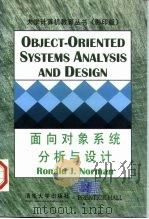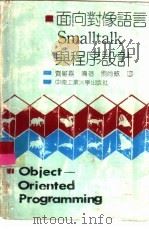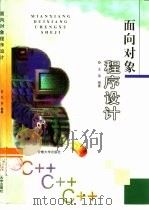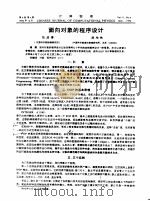《面向对象系统分析与设计》
| 作者 | (美)(R.J.诺曼)Ronald J.Norman著 编者 |
|---|---|
| 出版 | 北京:清华大学出版社 |
| 参考页数 | 430 |
| 出版时间 | 1998(求助前请核对) 目录预览 |
| ISBN号 | 730202944X — 求助条款 |
| PDF编号 | 87628388(仅供预览,未存储实际文件) |
| 求助格式 | 扫描PDF(若分多册发行,每次仅能受理1册) |

1.INTRODUCTION1
1.INTRODUCTION1
Chapter Objectives1
PartⅠSystems Analysis and Conceptual Design1
PartⅠSystems Analysis and Conceptual Design1
Systems Analysis and Design Has Many Other Names2
What is a System?4
What is an Information System?5
What is an Automated Information System?7
What are the Basic Characteristics of an Information System?8
What is Systems Analysis and Design?10
What Makes Systems Analysis and Design such a Difficult Human Endeavor?10
Stakeholders of an Information System12
Systems Analysis and Design as a Career13
What is a Systems Analyst Responsible For?14
What does a Systems Analyst Do?14
Systems Analysis and Design Skills and Activities15
General Model of Systems Analysis and Design17
The Detailed Activities of Analysis and Design18
Systems Analysis and Design Projects21
Where do Information Systems Analysis and Design Projects Come From?22
Information Systems Requirements Specification23
Information Systems Life Cycle and Information Systems Development Life Cycle (SDLC)24
Principles to Guide Information Systems Analysis and Design26
Summary27
Questions27
References28
2.FEASIBILITY ANALYSIS AND REQUIREMENTS DETERMINATION29
Chapter Objectives29
2.FEASIBILITY ANALYSIS AND REQUIREMENTS DETERMINATION29
Feasibility Analysis30
Feasibility Types30
Requirements Determination33
Problem Domain35
Frameworks for Understanding and Doing Requirements Determination37
Requirements Determination Sub-Activities38
The Pieces FrameWork38
Kozar s Requirements Model40
Object-Oriented Requirements Determination Modeling Activities44
Methods Used to Gather an Information System s Requirements45
Feedback to the User48
Requirements Ambiguity49
Summary51
Questions52
References53
3.AN OBJECT-ORIENTED METHODOLOGY AND MODEL55
Chapter Objectives55
Methodologies55
3.AN OBJECT-ORIENTED METHODOLOGY AND MODEL55
The Traditional Methodology56
Structured Analysis and Design Methodology56
Information Modeling Methodology58
Object-Oriented Methodology59
Key Characteristics of an Object-Oriented Methodology60
Two Classic Problems Resolved with Object-Oriented Analysis and Design66
Classification Theory67
Coad s Object-Oriented Analysis and Design Methodology and Notation68
Coad s Object-Oriented Methodology68
Coad s Object Model Components72
An Object-Oriented Model73
Summary82
Questions82
References83
4.OBJECTS AND CLASSES86
4.OBJECTS AND CLASSES86
Chapter Objectives86
Objects and Classes87
Object and Class Rules and Guidelines88
Class Attributes and Services Defined89
Comment on Object-Oriented Problem Solving Strategy91
Finding Objects92
Wirfs-Brock Noun Phrase Strategy92
Wirfs-Brock CRC Strategy94
Conglomeration Strategy94
The Video Store Example-Finding Objects96
A Future Enhancements Strategy98
Summary99
Questions100
References101
5.OBJECT RESPONSIBILITIES: ATTRIBUTES102
5.OBJECT RESPONSIBILITIES: ATTRIBUTES102
Chapter Objectives102
Attributes103
Determining Attributes106
Attribute Types107
Object-Oriented Methodology Strategy for Different Attribute Types109
Object-Oriented Strategy for Multivalue Attributes110
The Video Store Example-Identifying Attributes112
Summary113
Questions114
References115
6.OBJECT RESPONSIBILITIES: CLASS AND OBJECT CONNECTIONS116
6.OBJECT RESPONSIBILITIES: CLASS AND OBJECT CONNECTIONS116
Chapter Objectives116
WhoI Know Responsibility of an Object117
Generalization-Specialization Pattern118
Object Patterns118
Generalization-Specialization Inheritance125
Whole-Part Object Connection Pattern128
Heuristics for Finding Whole-Part Patterns134
Object Connection Patterns136
Video Store Example144
Questions147
Summary147
References148
7.OBJECT RESPONSIBILITIES: SERVICES AND SCENARIOS149
Chapter Objectives149
7.OBJECT RESPONSIBILITIES: SERVICES AND SCENARIOS149
What I Do Responsibility of an Object150
Business Objectives Tactics, Information Systems Objectives and Tactics, and Policies and Procedur150
Types of Services151
Basic Services151
Problem Domain Specific Services154
Finding and Identifying Services159
The Video Store Example-Identifying Services161
Other Techniques for Identifying Services162
Techniques for Documenting and Describing Service Details164
Service Details164
Scenarios165
Structured English or Pseudocode166
Decision Tables and Decision Trees168
A Decision Table Example171
A Decision Tree Example174
State-Transition Diagrams176
The Video Store Example-Assigning Services to Classes and Message Connections177
Transition from Systems Analysis to Systems Design180
Summary181
Questions182
References183
8.SYSTEMS DESIGN184
PartⅡPhysical Design Implementation184
8.SYSTEMS DESIGN184
Chapter Objectives184
PartⅡ Physical Design Implementation184
Information Systems Design185
Historical Information Systems Design185
An Object-Oriented Analysis and Design Methodology187
Information Systems Design Strategy Choices187
Object-Oriented Design193
Alternative Object-Oriented Information Systems Development Strategies202
Summary203
Questions204
References205
Chapter Objectives206
9.OUTPUT DESIGN206
9.OUTPUT DESIGN206
Output: High Quality, Usable Information207
Internal, External, and Turnaround Outputs209
Output Types209
Static and Dynamic Outputs211
Output Devices and Media212
Output: Report Types214
Output Formats214
Output: Graphs221
Output: Internal Controls225
Summary227
The Future of Output Design227
References228
Questions228
10.INPUT DESIGN229
10.INPUT DESIGN229
Chapter Objectives229
Introduction229
The Many Facets of Input Data231
Data Validation and Verification231
Input Data Methods232
Input Devices235
General Guidelines for Inputing Data235
Graphical User Interface (GUI)Design for Input242
Summary247
Questions247
References248
11.FILE AND DATABASE DESIGN249
Chapter Objectives249
11.FILE AND DATABASE DESIGN249
Files and Databases250
Data Structures252
Attribute Classifications254
File Types258
File Access and Organization262
Normalization265
Object-Oriented Database279
Evolution of Object-Oriented Database279
Characteristics of an Object-Oriented Data Model280
Strengths of an Object-Oriented Database282
Weaknesses of an Object-Oriented Database284
Summary284
Questions285
References285
12.SOFTWARE CONSTRUCTION AND TESTING286
12.SOFTWARE CONSTRUCTION AND TESTING286
Chapter Objectives286
Introduction286
General Software Design Principles288
Software Construction Framework291
Object-Oriented Software Construction Framework293
Software Construction Strategies293
Cohesion and Coupling295
Object-Oriented Cohesion and Coupling299
Software Testing299
Software Testing Strategies300
A Generic Software Testing Methodology303
Application and Code Generators308
Summary308
Questions309
References309
13.IMPLEMENTATION310
Chapter Objectives310
Introduction310
13.IMPLEMENTATION310
Install: The First Phase of Implementation311
Activate: The Second Phase of Implementation314
Institutionalization: The Final Phase of Implementation316
Organizational (Planned) Change for Information Systems318
The Stages of Organizational Change319
Action Research and Force Field Analysis322
Implementation Critical Success Factors325
Summary326
Questions326
References327
PartⅢ Modules—Miscellaneous Systems Analysis and Design Topics329
A.INFORMATION SYSTEMS PLANNING329
Module Objectives329
Introduction329
PartⅢ Modules-Miscellaneous Systems Analysis and Design Topics329
A.INFORMATION SYSTEMS PLANNING329
A Generic Information Systems Planning Methodology331
Why Engage in Information Systems Planning?334
Information Systems Planning Techniques and Methodologies335
Summary335
Questions335
References336
B.PROTOTYPING337
B.PROTOTYPING337
Module Objectives337
Prototypings Placement within a Systems Development Life Cycle338
Product versus Information Systems Prototyping Differences338
Prototyping Benefits339
Prototyping s Risk340
Prototyping Synonyms341
Enabling Technologies for Prototyping342
Does Prototyping Work?343
How to Initiate Prototyping344
Summary345
Questions345
References345
C.COMPUTER-AIDED SOFTWARE ENGINEERING (CASE)346
Module Objectives346
Introduction346
C.COMPUTER-AIDED SOFTWARE ENGINEERING (CASE)346
CASE Architecture347
The Stages of CASE Usage349
The Benefits of CASE349
The Issues of CASE349
Summary351
Questions351
References351
D.SOFTWARE PROCESS IMPROVEMENT353
Module Objectives353
D.SOFTWARE PROCESS IMPROVEMENT353
Introduction353
Immature and Mature Systems Development Organizations354
The Five Maturity Levels of the SEI Capability Maturity Model355
A Generic Systems Development Process Improvement Model358
The ISO 9000 Process Improvement Methodology359
Summary359
Questions360
References360
E.THE SYSTEMS DEVELOPMENT CHALLENGE361
E.THE SYSTEMS DEVELOPMENT CHALLENGE361
Module Objectives361
Introduction361
Software Development s Quadruple Constraint363
Information Technology Management Issues364
Systems Development Risks364
Systems Analysis and Design versus Software Engineering365
A Systems Development Architecture for the 1990s366
SDLC, Methodology, Technique, and Tool369
Summary371
Questions371
References372
F.PROJECT MANAGEMENT373
Module Objectives373
Introduction373
F.PROJECT MANAGEMENT373
Two Tools: PERT Network and Gantt Chart375
The PERT Network376
A PERT Network Example377
PERT Network Strengths and Weaknesses381
The Gantt Chart383
A Gantt Chart Example384
Summary384
Questions385
References386
G.COMMUNICATION AND ELECTRONIC MEETINGS387
G.COMMUNICATION AND ELECTRONIC MEETINGS387
Module Objectives387
Communication within an Information Systems Development Project388
Systems Development Project Communication Opportunities389
Problem Solving Session Strategy392
Electronic Meetings to Support Group Work393
Summary395
Questions395
References395
H.BUSINESS PROCESS REENGINEERING396
Module Objectives396
Introduction396
H.BUSINESS PROCESS REENGINEERING396
Lessons Learned from Organizations that Have Done It397
The Core of Business Process Reengineering398
A Business Process Reengineering Strategy399
Summary399
Business Process Reengineering is Organizational Change399
Questions400
References400
GLOSSARY401
GLOSSARY401
RECOMMENDED READING TO GET STARTED-AUGUST 1995410
RECOMMENDED READING TO GET STARTED-AUGUST 1995410
BIBLIOGRAPHY—OBJECT-ORIENTED TECHNOLOGY411
BIBLIOGRAPHY—OBJECT-ORIENTED TECHNOLOGY411
INDEX421
INDEX421
1998《面向对象系统分析与设计》由于是年代较久的资料都绝版了,几乎不可能购买到实物。如果大家为了学习确实需要,可向博主求助其电子版PDF文件(由(美)(R.J.诺曼)Ronald J.Norman著 1998 北京:清华大学出版社 出版的版本) 。对合法合规的求助,我会当即受理并将下载地址发送给你。
高度相关资料
-

- Java与面向对象程序设计教程
- 1999 北京:高等教育出版社
-

- UML面向对象设计与分析教程
- 2020
-

- 计算机软件新技术 面向对象的系统分析
- 1992 北京:清华大学出版社
-

- 新一代信息系统 面向对象信息系统的分析与设计
- 1993 北京:航空工业出版社
-

- Delphi与面向对象程序设计
- 1997 大连:大连理工大学出版社
-

- 面向对象程序设计语言
- 1993 北京:石油工业出版社
-

- 面向对象语言Smalltalk与程序设计
- 1990 长沙:中南工业大学出版社
-

- 面向对象程序设计
- 1994 北京:电子工业出版社
-

- CI系统分析与设计
- 1996 长沙:国防科技大学出版社
-

- 面向对象分析、设计及应用
- 1992 北京:国防工业出版社
-

- 面向对象程序设计导论
- 1995 杭州:浙江大学出版社
-

- 面向对象程序设计
- 1999 合肥:安徽大学出版社
-

- 面向对象程序设计基础
- 1998 北京:高等教育出版社
提示:百度云已更名为百度网盘(百度盘),天翼云盘、微盘下载地址……暂未提供。➥ PDF文字可复制化或转WORD

